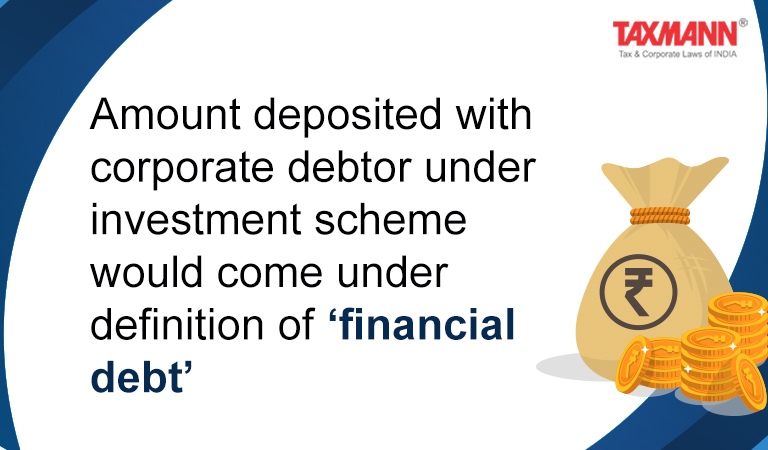Amount deposited with corporate debtor under investment scheme would come under definition of ‘financial debt’
- Blog|News|Insolvency and Bankruptcy Code|
- 2 Min Read
- By Taxmann
- |
- Last Updated on 18 October, 2021

Case Details: Mohanlal Dhakad v. BNG Global India Ltd. - [2021] 131 taxmann.com 44 (NCLAT- New Delhi)
Judiciary and Counsel Details
-
- Venugopal M., Judicial Member and Kanthi Narahari, Technical Member
- Ms. Ranjana Roy Gawai and Avinash Bhati, Advs. for the Appellant.
Facts of the Case
The Respondent/corporate debtor had accepted certain amounts from appellants/financial creditors under two investment schemes. Under investment plan, the corporate debtor had assured financial creditors that on the maturity of a particular scheme, financial creditors would either be allotted plots of land or be paid multi-fold returns on their investment.
However, on maturity, the corporate debtor failed to allot plots of land in favour of financial creditors and also failed to pay the amount payable on maturity along with the assured return.
Financial creditors, on the other hand, filed an application under section 7 for initiation of CIRP but the same was rejected by NCLT holding that amount which they had deposited with corporate debtor did not come within the purview of the definition of ‘financial debt’.
NCLAT Held
The essence of any debt to be mentioned as ‘financial debt’ is ‘time value of money, as borrowing money is for monetary transaction. Since ‘corporate debtor’ under ‘Investment Plan’ had assured to provide appellants/Investors interest on their investment sum along with investment amount, for ‘time value of money and it failed in its commitment to offer allotment/possession of ‘Plot of Land’ as promised by it or repay sums collected by it along with interest on the maturity of schemes, etc.,.
As a result, the ‘appellant’s position was that of a ‘financial creditor’ as per section 5(7) read with section 5(8) there being default in payment of accepted amounts by ‘respondent’/’corporate debtor’ and, therefore, CIRP application filed against the corporate debtor was to be admitted.
Case Review
-
- Mohan Lal Dhakad v. BNG Global India Ltd. [2021] 131 taxmann.com 43 (NCLT – NEW Delhi) (Para 35) reversed
List of Cases Referred to
-
- Innoventive Industries Ltd. v. ICICI Bank Ltd. [2017] 84 taxmann.com 320/143 SCL 625 (SC) (para 13)
- Nikhil Mehta & Sons v. AMR Infrastructure Ltd. [2017] 84 taxmann.com 163/143 SCL 278 (NCL – AT) (para 14)
- Ms. Anju Agarwal v. Bombay Stock Exchange [Company Appeal (AT) (Insolvency) No. 734 of 2018, dated 23-4-2019] (para 15)
- Bohar Singh Dhillon v. Rohit Sehgal [2019] 107 taxmann.com 32/154 SCL 394 (NCL – AT) (para 16)
- Encore Asset Reconstruction Co. (P.) Ltd. v. Ms. Charu Sandeep Desai [2019] 107 taxmann.com 100/154 SCL 382 (NCL – AT) (para 17)
- Embassy Property Developments (P.) Ltd. v. State of Karnataka [2019] 112 taxmann.com 56/[2020] 157 SCL 445 (SC) (para 18).
Disclaimer: The content/information published on the website is only for general information of the user and shall not be construed as legal advice. While the Taxmann has exercised reasonable efforts to ensure the veracity of information/content published, Taxmann shall be under no liability in any manner whatsoever for incorrect information, if any.

Taxmann Publications has a dedicated in-house Research & Editorial Team. This team consists of a team of Chartered Accountants, Company Secretaries, and Lawyers. This team works under the guidance and supervision of editor-in-chief Mr Rakesh Bhargava.
The Research and Editorial Team is responsible for developing reliable and accurate content for the readers. The team follows the six-sigma approach to achieve the benchmark of zero error in its publications and research platforms. The team ensures that the following publication guidelines are thoroughly followed while developing the content:
- The statutory material is obtained only from the authorized and reliable sources
- All the latest developments in the judicial and legislative fields are covered
- Prepare the analytical write-ups on current, controversial, and important issues to help the readers to understand the concept and its implications
- Every content published by Taxmann is complete, accurate and lucid
- All evidence-based statements are supported with proper reference to Section, Circular No., Notification No. or citations
- The golden rules of grammar, style and consistency are thoroughly followed
- Font and size that’s easy to read and remain consistent across all imprint and digital publications are applied





